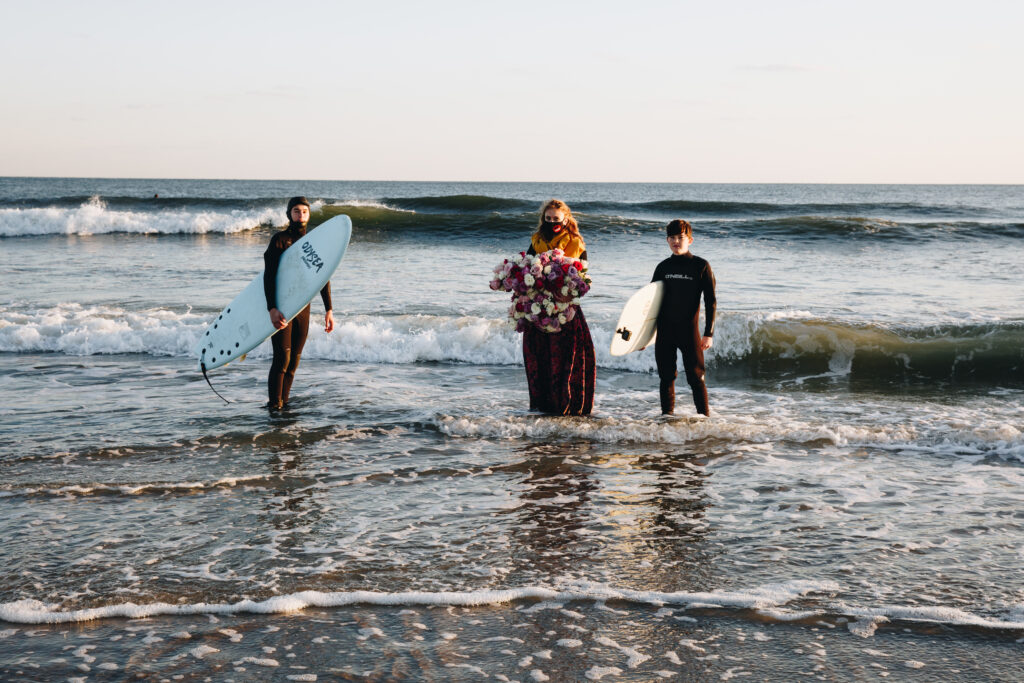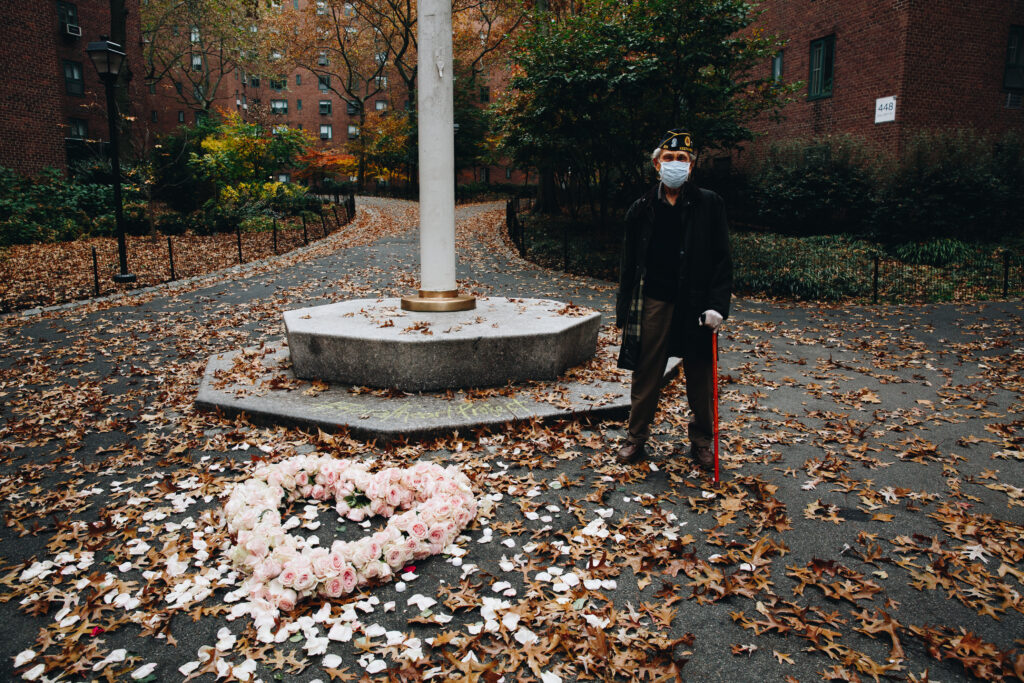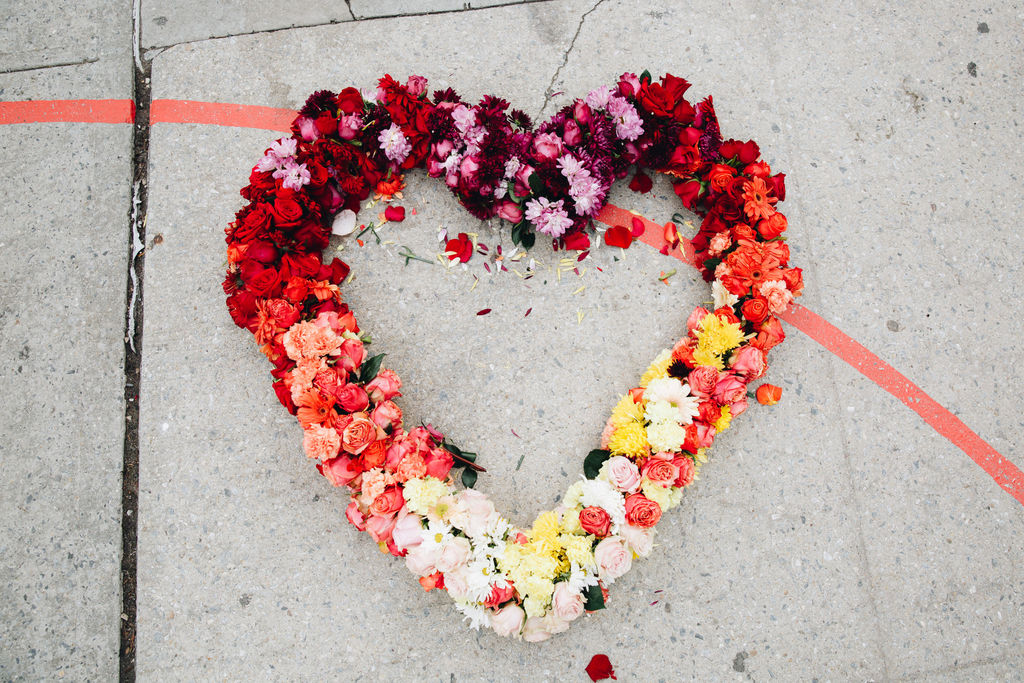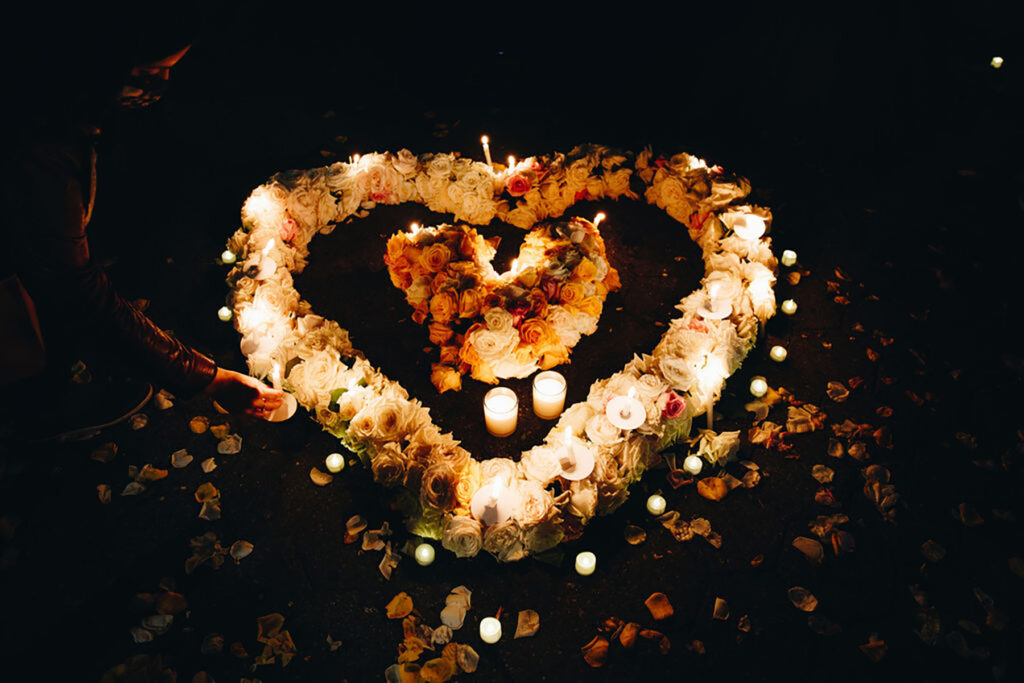Growing from Grief: Artist Kristina Libby’s Flower Memorials Honor Those Lost During COVID-19

During the many months of sheltering at home and New York City on lockdown, artist Kristina Libby began laying floral hearts around the city as a way to recognize and safely grieve those who lost their lives to COVID-19. What started as an independent project soon turned into The Floral Heart Project. In collaboration with an online florist, each floral heart wreath that comes out of The Floral Heart Project is made in honor of a specific person and their community at large. With a fascinating background in tech and cyber security, Libby’s art tackles the tough questions of what does grief, sadness and loss look like when we can’t come together to collectively mourn? How do you create art that recognizes a lost period of life?

All images courtesy of Erica Reade
This article has been a long time coming: back in March, I discovered Libby through a feature in the New York Post. Fast forward to fifteen months later, and The Floral Heart Project is still going strong. Despite the fact that the outside world seems less ominous and with vaccinations speeding up the process of returning to some level of ‘normal,’ grief, mourning and feeling of loss are still bubbling below the surface. The pandemic is still here, and it still lingers in our day-to-day lives and conversations. Our feelings of grief, fear grappling with loss, and uncertainty don’t evaporate overnight.
“If we do not mourn, we will carry the grief in our hearts and that will hurt us. Recognizing those who have left us, healing ourselves and caring for our community will instead create a richer, happier and healthier world.”

All images courtesy of Erica Reade
While we can certainly hope that the actual end to the pandemic is in sight, Libby’s work reminds us that grief is not linear nor does it have an end date. Grief is messy, uncomfortable and is going to look different from person to person. The goal of The Floral Heart Project is to capture that grief: “I want The Floral Heart Project to live on as long as it is needed. If people want hearts in their communities, I want to bring hearts to them and have this project help to be a response to grieve. In addition, I have recently launched a digital piece, Heartbleed, that is a next iteration or evolution of The Floral Heart Project. The Heartbleed digital display shows a rose petal dropping for every life lost to COVID-19 time to each day of loss. Every two seconds represents one day since the start of the pandemic.” This piece is more permanent. It displayed in Tribeca for two months and is now at the Arizona Historical Society using only AZ data and on display in Tennessee. The piece creates a 10 minute video montage that highlights our losses in a way that is somewhat manageable and palatable that then introduces space for conversation. “I want Heartbleed to anchor spaces where we can talk about grief,” says Libby.

All images courtesy of Erica Reade
“America needs a better way to grieve those who lost to COVID-19.
As things have begun to turn the corner in terms of active cases and deaths in the U.S., I reached back out to Libby to learn more about upcoming initiatives with The Floral Heart Project, and to walk me through the process of connecting with people who would like a memorial made as part of their healing process. The Floral Heart Project initiatives are adapting to new community needs; Libby is currently in talks with gardens and public spaces so hopefully people will have a more permanent and public space to openly grief and remember for years to come.

Credit: Erica Read
Grief, mourning and loss of time was a very prominent part of 2020, and many of us are grappling, trying to figure out how to process everything that has gone on. How did this project come about?
I was worried that without more public grieving and more spaces to mourn (in a safe way) we were on a runaway train to a national grief epidemic. Indeed, research on PTSD and delayed grief, shows that we should expect moderate to severe PTSD in around 15% of the population in respond to COVID trauma. That’s 50 million people. One way to off-set is to reinforce community and the community we needed right now, I felt, was community that stood in solidarity with those suffering. So, the project was my effort to show solidarity with the massive wave of loss and the rising grief.
Can you tell me a bit more about yourself as an artist, innovator and tech executive? In your mind, do these different roles come together
It took me a long time to feel comfortable creating and making art. In fact, it was not until I had a kitesurfing accident last summer and a traumatic brain injury as a result, that I really felt like compelled to devote myself to a more purposeful artistic practice. Prior to that I worked in technology and academia where I got to learn how to build and market a product. That has been essential in my very social-focused art practice. I don’t want to just make art; I want to make are that changes how we think, act and work together. So, knowing how to not just make something but how to get that in front of a lot of people and get them involved in the act of the creation has been invaluable.
From the get go, did you know that you would want to use flowers as your medium? From an outsider’s perspective, flowers seem very fitting as your chosen medium: they are beautiful, cheery, smell good but also have their own life cycle.
Yes. They were the most appropriate for a number of reasons. First, we’ve given flowers at funerals going back to 62,000 BC as found at a burial site Northern Iraq. But also they are such a powerful reminder of life: flowers are a dead thing but they remind us of life. They also last around 7 days which is the most intense period of the grieving process. Beyond that, I felt that they were such a reminder of the natural experiences we crave while trapped inside and they present a really visual break to the urban landscape. They surprise people.
Many people haven’t had a moment to grieve over their loved ones, and so many have been robbed of being able to safely give their loved ones a funeral or a memorial service. Do you often have people getting in touch, sharing their story and that in turn inspires a site specific piece? Can you walk me through how you work?
Yes. There are so many stories. It’s so much to hold and listen to but it’s such an honor to be told their stories. I try to make each piece in honor of a certain person and for the community at large. That allows me to think about who they are, their live and their gift and to give something back that feels equal to their loss.
Examples that come to mind include my piece in Washington Square park for Mama Hu. I wanted to make the most feminine beautiful wreath to be a reflection of her. But, part of the work happens in the creation of the piece: I spend a lot of time thinking about colors and placing them together next to each other in a way that builds and plays with each other.
The process is probably like this: Think of a location that I find meaningful to me or to the city. Tie a COVID story to that place. Pull together a color concept. See if I want to do anything different in a big way from past locations Receive the flowers and weave them together. Then so much of the feeling of the heart is also about the offering of the piece: is it done in vigil, me alone, me with a few close friends? Do I bring in music or dancers?
There is finally a secret: the garlands are heavy. I always carry them. In the fifteen or twenty feet of carrying them, often to music, I think of the weight of the bodies of those we have lost. I imagine carrying them. I cradle them. I lay them down with the reverence I would have for taking care of someone who had passed. That’s probably too gruesome to write about but it is very important to me.
In our last conversation, Libby added that she is very focused on other potential threats to our sense of culture and community, specifically cyberattacks which is a prolific threat to our digital normalcy: “Again, like a pandemic a cyberthreat is a threat we cannot see and yet it can eviscerate a country. So, what do we do? We need to find visual means to engage the topic. We need art to play a role in pushing conversation and developing spaces where we can connect. This is central to building an engaged and kind community.”
Libby’s work still packs a powerful punch, and opens the door for a larger conversation about community spaces for loss, and the need for permanent plaques or memorials to commemorate those that we lost.
Learn more about The Floral Heart Project, as well as upcoming initiatives.
What's Your Reaction?
Alexandra Israel graduated from Bates College in 2010. A museum aficionado since her introduction to Jean Dominque Ingres' portraits as a small child, she enjoys spending her free time at museums and finding off-the-beaten-track gallery shows. Israel has been working in PR for over seven years, primarily within book publishing and in the art world. She has held positions at Penguin Book Group, Aperture Foundation, and Third Eye among others. l Instagram l

